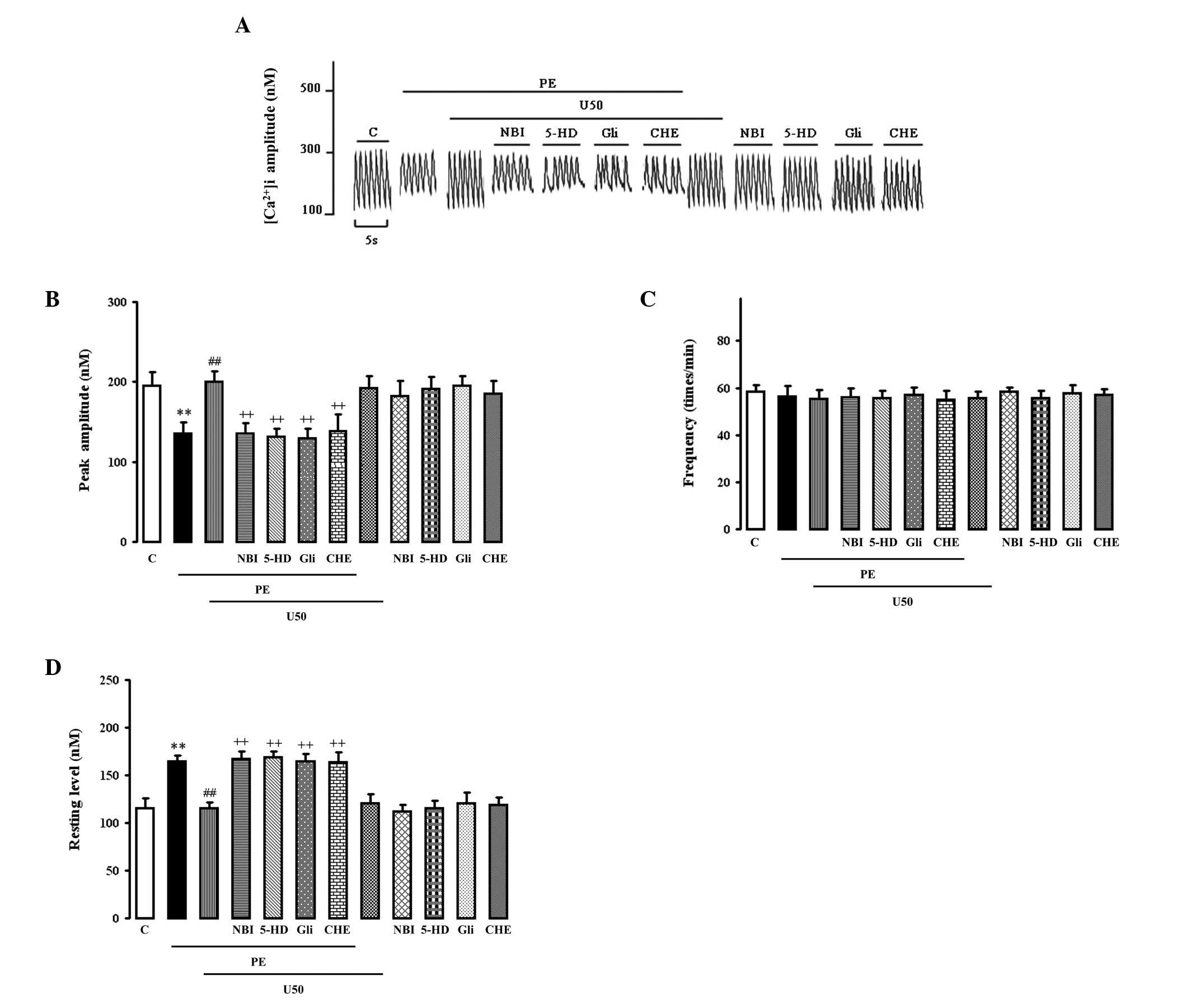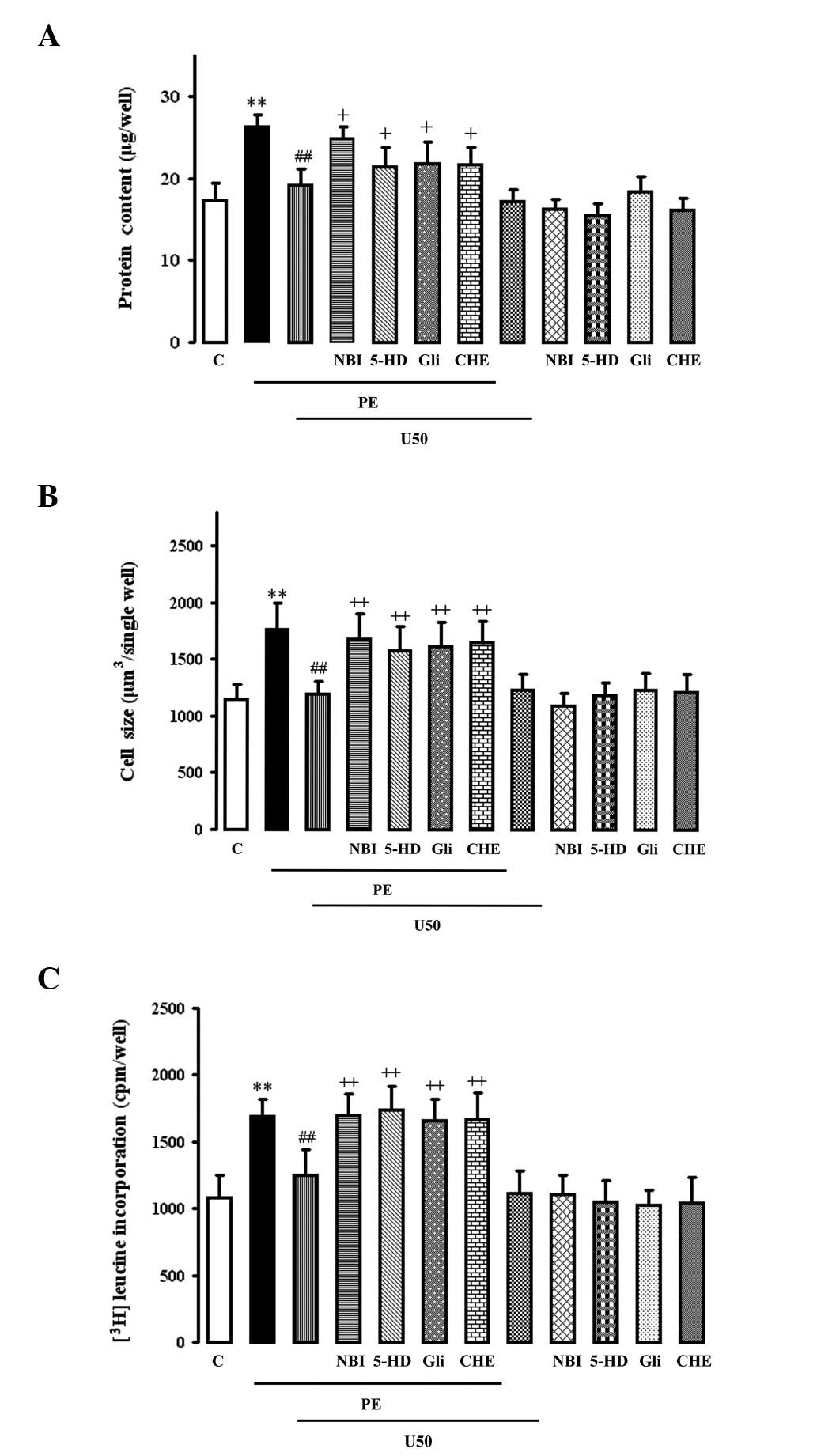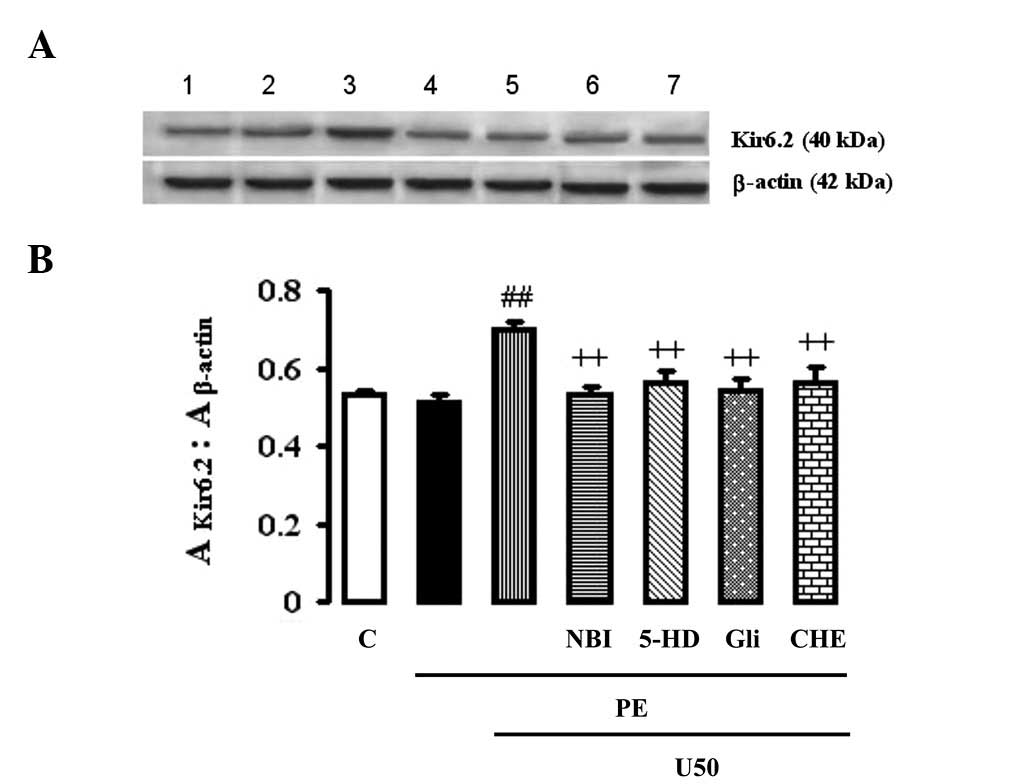|
1.
|
Frey N and Olson EN: Cardiac hypertrophy:
the good, the bad, and the ugly. Annu Rev Physiol. 65:45–79. 2003.
View Article : Google Scholar : PubMed/NCBI
|
|
2.
|
Yu XC, Li HY, Wang HX and Wong TM:
U50,488H inhibits effects of norepinephrine in rat
cardiomyocytes-cross-talk between kappa-opioid and beta-adrenergic
receptors. J Mol Cell Cardiol. 30:405–413. 1998. View Article : Google Scholar : PubMed/NCBI
|
|
3.
|
Shan D, Wang HX, Su YH, Jing Y and Wong
TM: kappa-opioid receptor stimulation inhibits cardiac hypertrophy
induced by beta1-adrenoceptor stimulation in the rat. Eur J
Pharmacol. 555:100–105. 2007. View Article : Google Scholar : PubMed/NCBI
|
|
4.
|
Sanada S, Node K, Asanuma H, Ogita H,
Takashima S and Minamino T: Opening of the adenosine
triphosphatesensitive potassium channel attenuates cardiac
remodeling induced by long-term inhibition of nitric oxide
synthesis: role of 70-kDa S6 kinase and extracellular
signal-regulated kinase. J Am Coll Cardiol. 40:991–997. 2002.
View Article : Google Scholar
|
|
5.
|
Xia Y, Rajapurohitam V, Cook MA and
Karmazyn M: Inhibition of phenylephrine induced hypertrophy in rat
neonatal cardiomyocytes by the mitochondrial KATP
channel opener diazoxide. J Mol Cell Cardiol. 37:1063–1067. 2004.
View Article : Google Scholar : PubMed/NCBI
|
|
6.
|
Seino S and Miki T: Physiological and
pathophysiological roles of ATP-sensitive K+ channels. Prog Biophys
Mol Biol. 81:133–176. 2003.
|
|
7.
|
Garlid KD, Paucek P, Yarov-Yarovoy V,
Murray HN, Darbenzio RB and D Alonzo AJ: Cardioprotective effect of
diazoxide and its interaction with mitochondrial ATP-sensitive K+
channels: possible mechanism of cardioprotection. Circ Res.
81:1072–1082. 1997.
|
|
8.
|
Oldenburg O, Cohen MV, Yellon DM and
Downey JM: Mitochondrial KATP channels: role in
cardioprotection. Cardiovasc Res. 55:429–437. 2002.
|
|
9.
|
Chen M, Zhou JJ, Kam KW, Qi JS, Yan WY and
Wong TM: Roles of KATP channels in delayed
cardioprotection and intracellular Ca2+ in the rat heart
as revealed by κ-opioid receptor stimulation with U50,488H. Br J
Pharmacol. 140:750–758. 2003.
|
|
10.
|
Light PE, Kanji HD, Fox JE and French RJ:
Distinct myoprotective roles of cardiac sarcolemmal and
mitochondrial KATP channels during metabolic inhibition
and recovery. FASEB J. 15:2586–2594. 2001. View Article : Google Scholar : PubMed/NCBI
|
|
11.
|
Pei JM, Wang YM, Zhu YL, Chen M and Wong
TM: Signaling pathway mediated by kappa-opioid receptor is impaired
in cardiac hypertrophy. Acta Pharmacol Sin. 22:887–895.
2001.PubMed/NCBI
|
|
12.
|
Huh J, Gross GJ, Nagase H and Liang BT:
Protection of cardiac myocytes via delta(1)-opioid receptors,
protein kinase C, and mitochondrial KATP channels. Am J
Physiol Heart Circ Physiol. 280:H377–383. 2001.PubMed/NCBI
|
|
13.
|
Wang Y, Hirai K and Ashraf M: Activation
of mitochondrial ATP-sensitive K+ channel for cardiac protection
against ischemic injury is dependent on protein kinase C activity.
Circ Res. 85:731–734. 1999.
|
|
14.
|
Zukin RS, Eghbali M, Olive D, Unterwald EM
and Tempel A: Characterization and visualization of rat and guinea
pig brain kappa-opioid receptors: evidence for kappa 1 and kappa 2
opioid receptors. Proc Natl Acad Sci. 85:4061–4065. 1988.
View Article : Google Scholar : PubMed/NCBI
|
|
15.
|
Rothman RB, Bykov V, Costa BR, Jacobson
AE, Rice KC and Brady LS: Interaction of endogenous opioid peptides
and other drugs with four kappa opioid binding sites in guinea pig
brain. Peptides. 11:311–331. 1990. View Article : Google Scholar : PubMed/NCBI
|
|
16.
|
Portoghese PS, Lipkowski AW and Takemori
AE: Binaltorphimine and nor-binaltorphimine, potent and selective
kappa-opioid receptor antagonists. Life Sci. 40:1287–1292. 1987.
View Article : Google Scholar : PubMed/NCBI
|
|
17.
|
Takemori AE, Ho BY, Naeseth JS and
Portoghese PS: Nor-binaltorphimine, a highly selective kappa-opioid
antagonist in analgesic and receptor binding assays. J Pharmacol
Exp Ther. 246:255–258. 1988.PubMed/NCBI
|
|
18.
|
Tortella FC, Echevarria E, Lipkowski AW,
Takemori AE, Portoghese PS and Holaday JW: Selective kappa
antagonist properties of nor-binaltorphimine in the rat MES seizure
model. Life Sci. 44:661–665. 1989. View Article : Google Scholar : PubMed/NCBI
|
|
19.
|
Tai KK, Bian CF and Wong TM: kappa-opioid
receptor stimulation increases intracellular free calcium in
isolated rat ventricular myocytes. Life Sci. 51:909–913. 1992.
View Article : Google Scholar : PubMed/NCBI
|
|
20.
|
Ventura C, Spurgeon H, Lakatta EG,
Guarnieri C and Capogrossi MC: kappa and delta opioid receptor
stimulation affects cardiac myocyte function and Ca2+
release from an intra-cellular pool in myocytes and neurons. Circ
Res. 70:66–81. 1992. View Article : Google Scholar : PubMed/NCBI
|
|
21.
|
Sheng JZ and Wong TM: Chronic U50,488H
abolishes inositol-1,4,5-trisphosphate and intracellular
Ca2+ elevations evoked by kappa-opioid receptor in rat
myocytes. Eur J Pharmacol. 307:323–329. 1996. View Article : Google Scholar : PubMed/NCBI
|
|
22.
|
Xia Y, Javadov S, Gan TX, Pang T, Cook MA
and Karmazyn M: Distinct KATP channels mediate the
antihypertrophic effects of adenosine receptor activation in
neonatal rat ventricular myocytes. J Pharmacol Exp Ther. 320:14–21.
2007.
|
|
23.
|
Simpson P and Savion S: Differentiation of
rat myocytes in single cell cultures with and without proliferation
nonmyocardial cells. Cross-striations, ultrastructure, and
chromotropic response to isoproterenol. Circ Res. 50:101–116. 1982.
View Article : Google Scholar
|
|
24.
|
Berk BC, Vekshtein V, Gordon HM and Tsuda
T: Angiotensin II-stimulated protein synthesis in cultured vascular
smooth muscle cells. Hypertension. 13:305–314. 1989. View Article : Google Scholar : PubMed/NCBI
|
|
25.
|
Lowry OH, Rosebrough NJ, Farr AL and
Randall RJ: Protein measurement with the Folin phenol reagent. J
Biol Chem. 193:265–275. 1951.PubMed/NCBI
|
|
26.
|
Zheng JS, Boluyt MO, Long X, O Neill L,
Lakatta EG and Crow MT: Extracellular ATP inhibits adrenergic
agonist-induced hypertrophy of neonatal cardiac myocytes. Circ Res.
78:525–535. 1996. View Article : Google Scholar : PubMed/NCBI
|
|
27.
|
Luo JD, Xie F, Zhang WW, Ma XD, Guan JX
and Chen X: Simvastatin inhibits noradrenaline-induced hypertrophy
of cultured neonatal rat cardiomyocytes. Br J Pharmacol.
132:159–164. 2001. View Article : Google Scholar : PubMed/NCBI
|
|
28.
|
Grynkiewicz G, Poenie M and Tsien RY: A
new generation of Ca2+ indicators with greatly improved
fluorescence properties. J Biol Chem. 260:3440–3450. 1985.
|
|
29.
|
Patel HH, Ludwig LM, Fryer RM, Hsu AK,
Warltier DC and Gross GJ: Delta opioid agonists and volatile
anesthetics facilitate cardioprotection via potentiation of
KATP channel opening. FASEB J. 16:1468–1470.
2002.PubMed/NCBI
|
|
30.
|
Holmuhamedov EL, Jovanovic S, Dzeja PP,
Jovanovic A and Terzic A: Mitochondrial ATP-sensitive K+ channels
modulate cardiac mitochondrial function. Am J Physiol.
275:1567–1576. 1998.
|
|
31.
|
Seymour EM, Wu SY, Kovach MA, Romano MA,
Traynor JR, Claycomb WC and Bolling SF: HL-1 myocytes exhibit PKC
and KATP channel-dependent delta opioid preconditioning.
J Surg Res. 114:187–194. 2003. View Article : Google Scholar : PubMed/NCBI
|
|
32.
|
Fryer RM, Wang Y, Hsu AK and Gross GJ:
Essential activation of PKC-delta in opioid-initiated
cardioprotection. Am J Physiol Heart Circ Physiol. 280:H1346–1353.
2001.PubMed/NCBI
|
|
33.
|
Ping P, Zhang J, Pierce WM and Bolli R Jr:
Functional proteomic analysis of protein kinase C epsilon signaling
complexes in the normal heart and during cardioprotection. Circ
Res. 88:59–62. 2001. View Article : Google Scholar : PubMed/NCBI
|
|
34.
|
Hu K, Duan D, Li GR and Nattel S: Protein
kinase C activates ATP-sensitive K+ current in human and rabbit
ventricular myocytes. Circ Res. 78:492–498. 1996.
|
|
35.
|
Fryer RM, Hsu AK, Eells JT, Nagase H and
Gross GJ: Opioid-induced second window of cardioprotection:
potential role of mitochondrial KATP channels. Circ Res.
84:846–851. 1999. View Article : Google Scholar : PubMed/NCBI
|

















